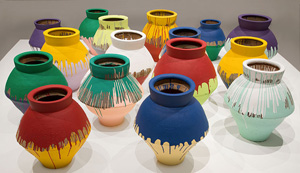When Art Was Dangerous
Some political artists want to change the way you think. Ai Weiwei just wants you to relate—and it is the subject of a longer review, in my latest upload.
The Chinese artist has paid dearly for asking you to listen. He has suffered house arrest and prison. He has been beaten, and he displays MRIs of his brain hemorrhage as a work of art. He presents his work as both documentary record and personal history. He ends up at once too detached and too sentimental, too literal and too eager to please. Yet he can still recover something precious about art, its dangers. 
Ai spent eighty-one days in prison, in 2011. He had not demanded an end to the regime for its record on human rights, because in China (face it) there are limits. Officials had even commissioned him as an artistic consultant to the Beijing National Stadium in 2008, and they encouraged his Shanghai studio as part of a growing arts district—although they soon enough tore it down. No, he had merely called China to account for the loss of life in the 2008 Sichuan earthquake, and indeed he had titled his exhibition in Munich the year before “So Sorry.” For Ai’s retrospective, through yesterday (August 10) at the Brooklyn Museum, he fills a long wall with the names of dead children, ruled like a ledger. You may also stop to hear a recital of their names, for he feels so close that he can almost talk to them and hear them speak.
In his art, too, Ai wants to build a lasting foundation and to demand a personal response. One need not even enter the museum lobby to encounter his aspirations, in the weight of six iron boxes, as imposing as anything by Richard Serra. The same materials take the shape of milk cartons at the base of each one, and kids are among the first to climb up to peek into each box. When they do, they see a recreation of what Ai calls the six worst moments in his confinement, although they look ordinary enough. One may sense nothing more than the precious humanity of eating, sleeping, and using the toilet. One will not feel the threat of Serra’s towering walls and flung lead.
One will, however, find it easy to respond, maybe even too easy. He covers a floor with rebar—more than seventy tons salvaged from the ruins, each bar painstakingly made straight. He has carpeted rooms in the past with sunflower seeds in hand-painted porcelain. When he spreads more than three thousand crabs in a circle of red and blue, because “river crabs” sounds like “harmonious” in Chinese, he is mocking the language of state propaganda. Yet he also cherishes the harmony, in opposition to a snake coiled on the ceiling above. As he lays his art flat to the floor, he is spreading its beauty, while also flattening the allusions.
 As an artist, Ai aims for the heart. He also goes right for the literal, with the stark equation of Minimalism and brutality in those boxes—or the pale realism of the props and fiberglass models within. His retrospective hardly bothers with chronology, as curated by Mami Kataoka of the Mori Art Museum in Tokyo and Brooklyn’s Sharon Matt Atkins, for his art is almost always in the present, even when it recalls China’s past. And he does borrow from Chinese traditions, as with sculpture in precious woods. A rosewood box recalls one that belonged to his father, a poet denounced as a Rightist, while loose tea takes on unexpected weight as houses. Naturally it also carpets the floor.
As an artist, Ai aims for the heart. He also goes right for the literal, with the stark equation of Minimalism and brutality in those boxes—or the pale realism of the props and fiberglass models within. His retrospective hardly bothers with chronology, as curated by Mami Kataoka of the Mori Art Museum in Tokyo and Brooklyn’s Sharon Matt Atkins, for his art is almost always in the present, even when it recalls China’s past. And he does borrow from Chinese traditions, as with sculpture in precious woods. A rosewood box recalls one that belonged to his father, a poet denounced as a Rightist, while loose tea takes on unexpected weight as houses. Naturally it also carpets the floor.
His art is often double edged but not necessarily edgy. Ai sustains a bad-ass attitude and a healthy sense of humor, as when he directs his middle finger at the camera. His friendly, banal style often holds a touch of cunning aggression. He is also, to his credit, first and foremost a visual artist, without the dependence on text art, conceptualism, crawl screens, and mass-media quotation of much political art in America. He is literal, but not dogmatic. One can enjoy his work for its irony or its innocence, because so plainly does he.
| Read more, now in a feature-length article on this site. |
SOURCE: Haberarts - Read entire story here.
Read More